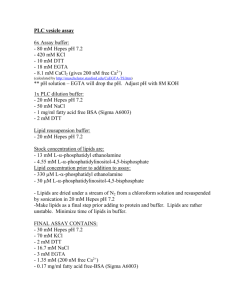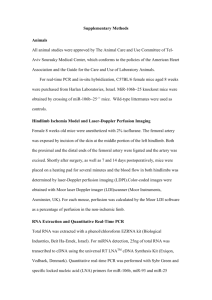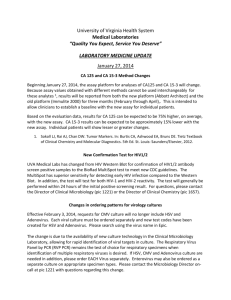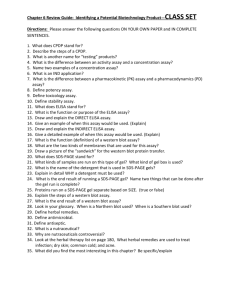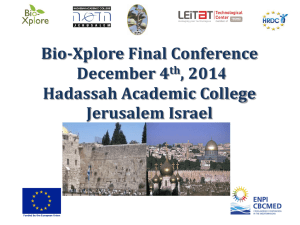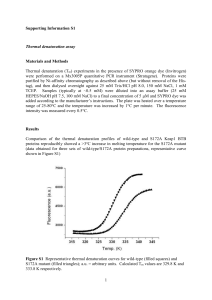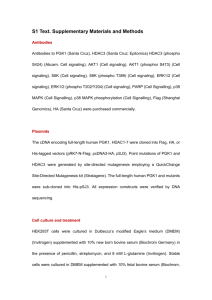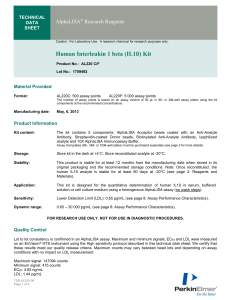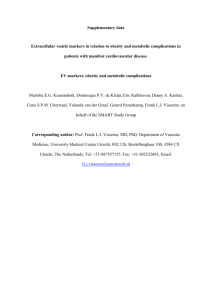Supplemental Digital Content 2: Materials and Methods The specific
advertisement
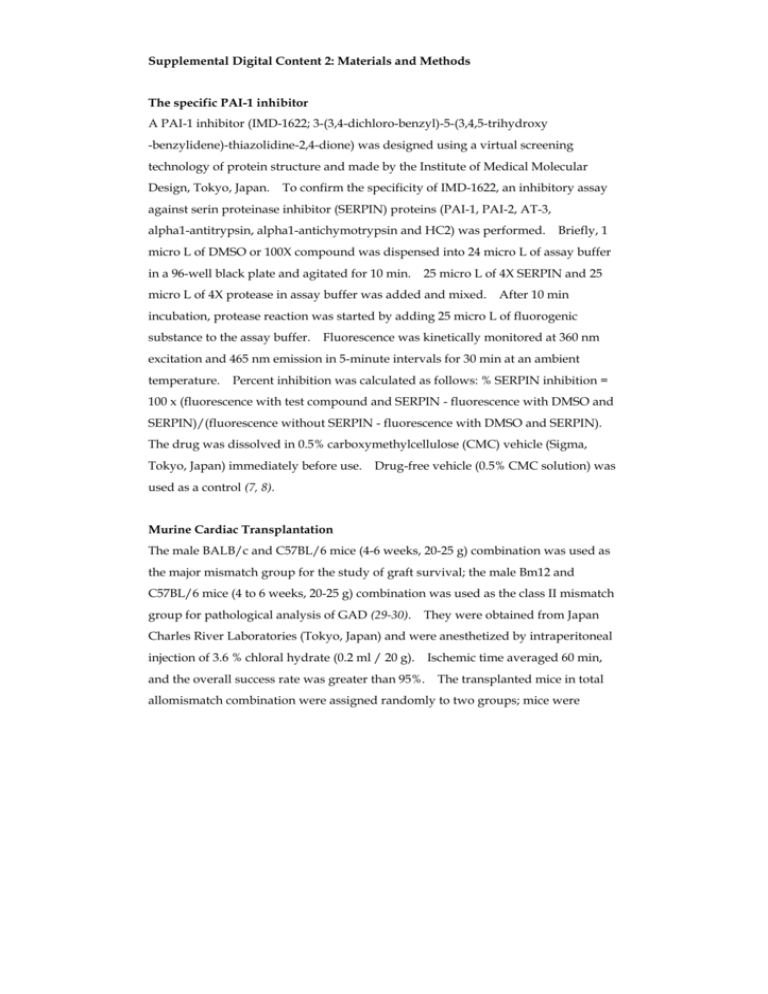
Supplemental Digital Content 2: Materials and Methods The specific PAI-1 inhibitor A PAI-1 inhibitor (IMD-1622; 3-(3,4-dichloro-benzyl)-5-(3,4,5-trihydroxy -benzylidene)-thiazolidine-2,4-dione) was designed using a virtual screening technology of protein structure and made by the Institute of Medical Molecular Design, Tokyo, Japan. To confirm the specificity of IMD-1622, an inhibitory assay against serin proteinase inhibitor (SERPIN) proteins (PAI-1, PAI-2, AT-3, alpha1-antitrypsin, alpha1-antichymotrypsin and HC2) was performed. Briefly, 1 micro L of DMSO or 100X compound was dispensed into 24 micro L of assay buffer in a 96-well black plate and agitated for 10 min. 25 micro L of 4X SERPIN and 25 micro L of 4X protease in assay buffer was added and mixed. After 10 min incubation, protease reaction was started by adding 25 micro L of fluorogenic substance to the assay buffer. Fluorescence was kinetically monitored at 360 nm excitation and 465 nm emission in 5-minute intervals for 30 min at an ambient temperature. Percent inhibition was calculated as follows: % SERPIN inhibition = 100 x (fluorescence with test compound and SERPIN - fluorescence with DMSO and SERPIN)/(fluorescence without SERPIN - fluorescence with DMSO and SERPIN). The drug was dissolved in 0.5% carboxymethylcellulose (CMC) vehicle (Sigma, Tokyo, Japan) immediately before use. Drug-free vehicle (0.5% CMC solution) was used as a control (7, 8). Murine Cardiac Transplantation The male BALB/c and C57BL/6 mice (4-6 weeks, 20-25 g) combination was used as the major mismatch group for the study of graft survival; the male Bm12 and C57BL/6 mice (4 to 6 weeks, 20-25 g) combination was used as the class II mismatch group for pathological analysis of GAD (29-30). They were obtained from Japan Charles River Laboratories (Tokyo, Japan) and were anesthetized by intraperitoneal injection of 3.6 % chloral hydrate (0.2 ml / 20 g). Ischemic time averaged 60 min, and the overall success rate was greater than 95%. The transplanted mice in total allomismatch combination were assigned randomly to two groups; mice were treated daily with 20 mg/kg/day of the PAI-1 inhibitor intraperitoneally (n=6); the other mice (n=6) received the same volume of vehicle for the control. Graft survival was assessed by graft palpation. The mice with class II mismatch combination were also assigned randomly to two groups; mice were treated daily with 20 mg/kg/day of the PAI-1 inhibitor intraperitoneally (n=10); the other mice (n=10) received the same volume of vehicle for the control. The class II mismatch allografts were harvested at day 60 after transplantation. During the observation period, we investigated whether adverse effects (bleeding complications, insufficient response to infections, etc.) occurred or not. This investigation conforms with the Guide for the Care and Use of Laboratory Animals in the Tokyo Medical and Dental University and University of Tokyo. Histological Examination and Morphometry Isografts and allografts of the class II mismatch group were harvested on day 60 after transplantation for analysis of GAD and myocardial cell infiltration. Grafts were sectioned transversely at the maximal circumference of the ventricle. As previously described, serial sections (6 µm) from tissue embedded in OCT were stained with hematoxylin eosin (HE) and Elastica van Gieson (EvG) to highlight the internal elastic lamina (IEL). The grafts were photographed, videodigitized and processed using an image analysis system (NIH Image). The area encompassed by the lumen and IEL was traced carefully, and the area of luminal stenosis in each cross section was calculated according to the formula: luminal occlusion = (IEL area - luminal area)/IEL area. Scores of two independent reviewers were averaged (3, 5, 30). Immunohistochemistry Serial sections (6 µm) were cut and dipped in cold acetone for 10 minutes. The sections were rehydrated in PBS and incubated with 5% normal goat serum to block non-specific reactions. Sections were incubated with primary antibody against murine CD4, CD8, CD11b (BD Biosciences Pharmingen, San Diego, CA), intercellular adhesion molecule (ICAM)-1 (YN1/1.7), proliferating cell nuclear antigen (PCNA) (Santa Cruz Biotechnology Inc., Santa Cruz, CA) or fibrinogen (A0080, Dako) for 12 h at 4 C. Antibody-biotin conjugate was detected with Vectastain ABC Kit (Vector, Burlingame, CA) used according to the manufacturer's instructions. Enzyme activity was detected with diaminobenzidine (0.5 mg/ml) with 0.05% NiCl2 in 50 mM Tris buffer, pH 7.5. Immunohistochemical analyses were performed by independent observers using qualitative scoring as previously reported (0, absent; 1, weak, focal; 2, weak, diffuse; 3, strong, focal; 4, strong, diffuse, and 5 very strong and diffuse). Scores uniformly fell within one grade of each other and were averaged (29, 30). Zymography Tissues were snap-frozen in liquid nitrogen and homogenized in 0.5ml of ice-cold lysis buffer (containing 50mM Tris-HCl, pH6.8, 150mM NaCl, 1mM PMSF, 2ng/ml aprotinin, 1% Triton X-100, 1% SDS, 1% sodium deoxycholate). Samples were centrifuged for 10 minutes at 4°C at 20,000G and the supernatant was transferred to clean new tubes. Protein concentration was determined by use of a BCA protein assay (Pierce Biotechnology). The extracted samples were stored at -80°C until use. Protein samples (each 25 micro g) were adjusted to 15 microL, and mixed with an equal volume of 2×loading buffer (containing 125mM Tris-HCl, pH6.8, 20% glycerol, 4% SDS, 0.05% bromophenol blue), and incubated for 10 minutes at room temperature. 6% gelatin gel was run at 80V until the bromophenol blue tracking dye reached the bottom of the gel. The gel was incubated in zymogram renaturing buffer (Invitrogen Corp, Carlsbad, CA) for 30 minutes, and replaced with fresh zymogram developing buffer (Invitrogen) and incubated at 37 C for 16 hours. The gel was stained with 0.2% Coomassie blue G 250 for 2 hours and destained with methanol: acetic acid: water (5: 1: 4) for 30 minutes. The quantitative scoring was performed using the Image J software (NIH). Real-time RT-PCR Total RNA was isolated from the hearts or cultured cells and cDNA was prepared with the RT-PCR Kit (Stratagene Co., La Jolla, CA). Real-time PCR in a StepOne real-time PCR system (Applied Biosystems) was used to determine the mRNA expression of interferon (IFN)-gamma (Assay ID: Mm00801778_m1), tumor necrosis factor (TNF)-alpha (Assay ID: Mm00443258_m1), interleukin (IL)-2 (Assay ID: Mm00434256_m1), IL-6 (Assay ID: Mm00446190_m1), IL-10 (Assay ID: Mm00439616_m1), monocyte chemoattractant protein (MCP)-1 (Assay ID: Mm00441242_m1), IFN-gamma-inducible protein of 10 kD (IP-10) (Assay ID: Mm00445235_m1), macrophage inflammatory protein (MIP-1) alpha (Assay ID: Mm00441258_m1), MIP-1 beta (Assay ID: Mm00443111_m1), PAI-1 (Mm00435858_m1) and 18s rRNA (Assay ID: Hs99999901_s1) as a control. The real-time PCR protocol consisted of an initial step at 95°C for 20 sec followed by 50 cycles: 95°C for 1 sec, annealing at 60 °C for 20 sec. cDNA was run in duplicates and quantitative data was calculated using the comparative CT (CT) method. Cell Proliferation Assay Single-cell splenocyte suspensions were prepared by dissociating tissue with frosted glass slides. A total of 5 X 105 naive responder cells were cultured with an equal number of mitomycin-C treated stimulator cells in 96 well plates in C/10 media. The PAI-1 inhibitor was added to each well at various concentrations (low, 10-10 M; middle, 10-9 M; and high, 10-8 M). Proliferation was assessed at 37C under 5% CO2 on days 2 through 4. Cell proliferation was assessed with the Cell Counting Kit-8 (Dojindo, Tokyo, Japan). Cell proliferation was expressed as the optical density (29). Enzyme-linked Immunosorbent Assay (ELISA) Supernatant was collected from cultures used for cell proliferation assay. Concentrations of IFN-gamma were determined with ELISA kits (BioSource International, Camarillo, CA) according to the manufacturer’s instructions (29). Statistical Analysis All data are expressed as mean +/- SD. Scores were compared among the groups using a Scheffe's ANOVA. Differences with values of P < 0.05 were considered significant.
